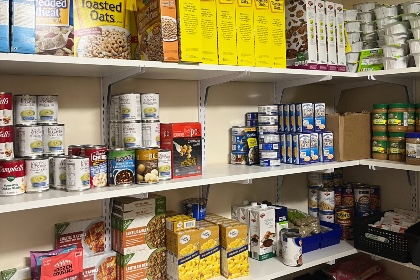May 23, 2024 by
John Turner and Janet Franz
A “food pharmacy” at UVM Children's Hospital provides food to pediatric patients and families in Vermont, where two in five people currently experience hunger, and families with children are five times more likely than others to face food insecurity. As demand continues to grow, the Children's Hospital hopes to expand the service across the health network.

The food pharmacy at UVM Children's Hospital provides food to pediatric patients and families.
Two in five Vermonters are experiencing hunger currently, according to Hunger Free Vermont, an organization that works to end hunger statewide. This troubling reality touches all communities in the state, including the University of Vermont, where students run Rally Cat's Cupboard, a food pantry that provides food to students and UVM employees. In 2023, the UVM food pantry received more than 17,000 visits.
Hunger Free Vermont also reports that families with children are five times more likely than others to face food insecurity, defined as not having access to sufficient food to meet one’s basic needs. For families experiencing food insecurity, seeking help can create stress and anxiety, especially when also navigating an illness.
Through a grassroots effort led by the pediatric cystic fibrosis care team and key partners, the UVM Children’s Hospital operates a “food pharmacy” in the Children’s Specialty Center. Each week, 20–30 families receive canned and boxed food, frozen vegetables, and meat. The seeds of this initiative were planted in the mid-2010s, and, through state grants and philanthropic support during the past several years, it has become an invaluable resource to pediatric patients and families.
“We had been screening for food insecurity on our inpatient pediatric unit since 2012, and we found that patients with cystic fibrosis had a higher rate of food insecurity,” says Keith Robinson, M.D., associate professor of pediatrics and a pediatric pulmonologist. “This is important because patients with cystic fibrosis often have trouble absorbing food and calories. They also need more calories to fight off infection. Not having access to food was a real threat to their health.”
Once the scope of need was identified, the idea to help families access nutritious food within the Children’s Hospital took shape. “Initially, Christine Prior, our clinic social worker, and I purchased some food and kept it in the physician dictation room,” says Robinson. Donations and a grant from the Vermont Foodbank helped increase the food supplies. “Currently, we have a large closet containing the food with a refrigerator and freezer. Demand is definitely growing.”
Over time, access to the food pharmacy expanded to additional families in the pediatric inpatient unit, the children’s specialty center, and pediatric primary care. “Our inpatient units and primary care clinics now also screen for food insecurity and other health-related social needs. They can also provide grocery cards for patients and families,” says Robinson, adding that all families who screen positive for food insecurity receive referrals to local resources and oral health supplies along with food. The team hopes to expand the service across across the health network.
While the core goal of the pharmacy is to feed hungry families, it also builds trust between families and care providers, Robinson says. “I feel that they trust our teams more because we are really thinking about what they need to be healthy,” including reducing food insecurity and stress.